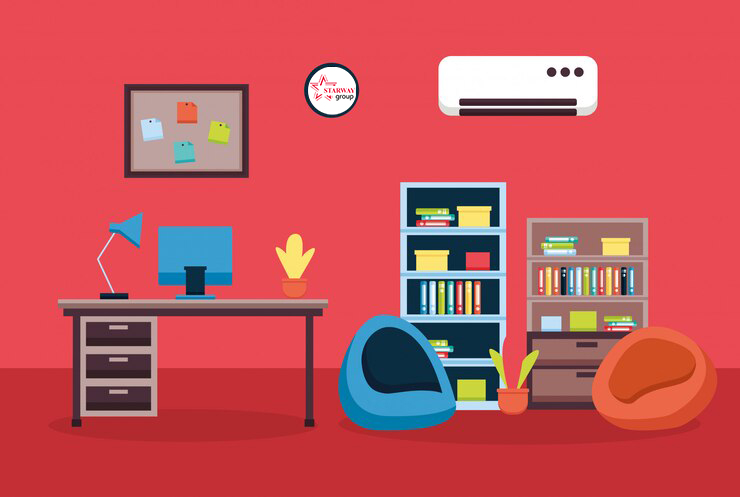
AIR CONDITIONER: TYPES, WORKING PRINCIPLE & IT’S FUNCTIONS
An air conditioner (AC) is a device designed to regulate the temperature, humidity, and air quality of an indoor space by cooling the air. It works by removing heat and moisture from the air inside a room or building, replacing it with cooler air, which helps create a more comfortable environment, especially during hot weather. Air conditioners also help control humidity, providing additional comfort in regions with high moisture levels.
How Does an Air Conditioner Work?
The basic working principle of an air conditioner relies on the refrigeration cycle, which involves the following key components:
- Evaporator: Located indoors, this part absorbs heat from the room air using a cold refrigerant, which evaporates into a gas.
- Compressor: Located outdoors, the compressor pumps the refrigerant gas to increase its pressure and temperature.
- Condenser: Also located outdoors, this component releases the heat absorbed from the indoor air by cooling and converting the refrigerant back into a liquid.
- Expansion Valve: This valve controls the flow of refrigerant into the evaporator, where the cycle begins again.
Functions of an Air Conditioner:
- Cooling: The primary function is to cool down the indoor environment by removing heat.
- Dehumidification: Reduces moisture levels in the air, making the environment feel cooler and more comfortable.
- Air Filtration: Some air conditioners come with filters to remove dust, pollen, and other allergens from the air.
Types of Air Conditioners:
There are several types of air conditioners, such as:
1. Central Air Conditioner
- Description: Cools an entire home or building using a centralized system of ducts. It has an outdoor unit that works with an indoor air handler.
- Best For: Large homes, offices, or commercial buildings.
- Key Features: Provides uniform cooling throughout the building, uses ductwork, high cooling capacity.
2. Split Air Conditioner
- Description: Consists of an outdoor compressor/condenser unit and an indoor air-handling unit. Common for residential use.
- Best For: Cooling individual rooms or specific zones in homes or offices.
- Key Features: No ductwork required, easy installation, energy-efficient, and provides zoned cooling.
Split Air Conditioners are divided into various types based on design, functionality, and application. Below are the main types of Split Air Conditioners:
2.1. Wall-Mounted Split AC
- Description: This is the most common type of split air conditioner, with an indoor unit mounted on the wall and an outdoor unit placed outside the building.
- Best For: Homes, offices, and small commercial spaces.
- Key Features: Easy to install, energy-efficient, and available in various cooling capacities. It’s also aesthetically pleasing, as only the indoor unit is visible.
2.2 Floor-Mounted Split AC
- Description: The indoor unit is placed on the floor instead of being mounted on the wall. It is suitable for rooms with limited wall space or low ceilings.
- Best For: Spaces where wall mounting isn’t practical, such as rooms with slanted walls or glass walls.
- Key Features: Easy access for maintenance, quick cooling, and convenient placement.
2.3. Ceiling Cassette Split AC
- Description: Installed in the ceiling, this type distributes cool air in four directions from the center. The indoor unit is mounted in the ceiling, and the outdoor unit remains outside the building.
- Best For: Large rooms, open-plan areas, offices, and commercial spaces.
- Key Features: Even air distribution, quiet operation, and a discreet design with only the grille visible.
2.4. Ceiling-Mounted/Floor-Ceiling Split AC
- Description: This system offers flexible installation, allowing the indoor unit to be either mounted on the ceiling or close to the floor.
- Best For: Large areas like conference rooms, halls, and commercial spaces.
- Key Features: Versatile installation, effective for large open spaces, and quiet operation.
2.5. Ducted Split AC
- Description: A concealed type of split system where the indoor unit is hidden in the ceiling or behind walls, and cool air is distributed through a network of ducts.
- Best For: Large homes, offices, or commercial buildings with multiple rooms.
- Key Features: Aesthetically pleasing as the system is hidden, provides uniform cooling across multiple rooms, and offers quiet operation.
2.6. Multi-Split Air Conditioner
- Description: A single outdoor unit connected to multiple indoor units, each installed in different rooms or zones.
- Best For: Homes or buildings where multiple rooms need individual cooling, but space for multiple outdoor units is limited.
- Key Features: Zoned cooling for different rooms, energy-efficient, and space-saving with only one outdoor unit.
3. VRF/VRV Split AC System
- Description: Variable Refrigerant Flow (VRF) or Variable Refrigerant Volume (VRV) systems are advanced split systems that allow for multiple indoor units connected to a single outdoor unit, with variable refrigerant flow to each unit.
- Best For: Large commercial buildings, hotels, or multi-room homes.
- Key Features: Zoned cooling and heating, high energy efficiency, and can simultaneously cool and heat different areas.
4. Window Air Conditioner
- Description: A compact unit installed in a window or through a wall, cooling the room directly.
- Best For: Small rooms or apartments.
- Key Features: Affordable, easy to install, but only suitable for small spaces.
5. Portable Air Conditioner
- Description: A standalone unit that can be moved from room to room. It requires venting through a window or door to expel heat.
- Best For: Temporary or flexible cooling needs in small spaces.
- Key Features: Portable, easy to set up, requires venting, and typically used for small areas.
6. Packaged Air Conditioner
- Description: Combines the compressor, condenser, and evaporator into a single unit, typically installed on the roof or near the foundation of a building. It distributes cooled air through ducts.
- Best For: Small commercial buildings or homes where space for a split system is limited.
- Key Features: Space-saving, all-in-one unit, used for cooling large spaces.
7. Evaporative Cooler (Swamp Cooler)
- Description: Uses water to cool the air by evaporation. It pulls hot air through water-saturated pads and cools the air as it passes through.
- Best For: Dry, arid climates.
- Key Features: Inexpensive, energy-efficient, but only effective in dry environments and adds humidity.
8. Hybrid/Dual Fuel Air Conditioner
- Description: A system that switches between electric power and fossil fuels to optimize energy efficiency, using electricity for cooling and gas for heating.
- Best For: Areas where both heating and cooling are required, especially with fluctuating temperatures.
- Key Features: Energy-efficient, cost-effective in the long run, environmentally friendly.
9. Geothermal Air Conditioner
- Description: Uses underground pipes filled with a refrigerant or water to heat and cool a building by utilizing the stable underground temperature.
- Best For: Long-term investment in eco-friendly, energy-efficient solutions for homes or commercial buildings.
- Key Features: Extremely efficient, lower operating costs, environmentally friendly, but requires significant initial investment.
